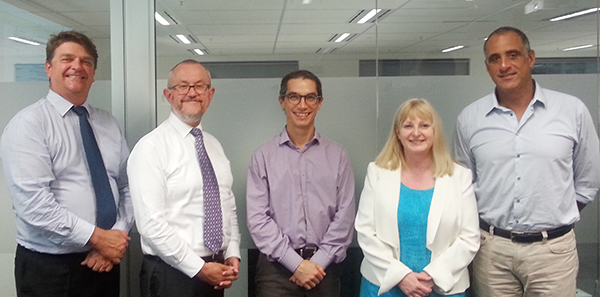1:30min

Christine Craigie, president Optometry NSW/ACT with (L-R) Dr Ross Ferrier and Dr Michael Hennessy, co-chairmen of the Ophthalmology network; Dr Yves Kerdraon and Dr Raf Ghabrial
______________________________
By Rhiannon Riches
Assistant Editor
A new community eye clinic that will only screen and assess patients with diabetic retinopathy and glaucoma is set to open in Western Sydney before mid-year.
Depending on the severity of their condition, patients screened at the clinic will be either managed by a local optometrist or referred to the Westmead Eye Clinic at Westmead Hospital for treatment.
The new community eye clinic, to open in Westpoint Shopping Centre in Blacktown, is part of a project modelled on an ongoing program established in Cambridge, United Kingdom, in 2010. The Cambridge community Optometry Glaucoma Scheme has been successful in better managing patients with glaucoma.
The project in Westmead is part of the C-Eye-C Project, shorthand for Community Eye Care Project. It is the flagship model for a wider project established by the Agency for Clinical Innovation (ACI).
Dr Andrew White, an ophthalmologist at Westmead Eye Clinic, is chairman of the C-Eye-C Project. He said diabetes and glaucoma were a huge issue in Western Sydney, with a growing and ageing population.
‘Westmead Eye Clinic receives hundreds of referrals a month. There is no way we can see all those patients; it’s not possible. We physically don’t have the space and there are not enough hours in the day,’ he said.
Dr White was involved in the referral scheme for low-risk glaucoma patients in Cambridge. This scheme focused only on glaucoma cases. On the basis of referral, all low-risk cases were instructed to see one of three optometrists taking part in the program.
‘The results of each patient’s consultation with an optometrist were sent to ophthalmologists taking part in the scheme to review,’ Dr White said.
‘We’re co-opting that project in Western Sydney. The scope of the C-Eye-C Project is much bigger than the model in Cambridge, but the goal is the same: to reduce the flood of low-risk cases referred to ophthalmology.
‘We have the money and authority to open a shop-front, for want of a better term, in Blacktown to assess low-risk patients. Low-risk patients will have testing there, for diabetic retinopathy and glaucoma. That information will come to us at Westmead Eye Clinic at various intervals for review.
‘The community eye clinic will open at Westpoint Shopping Centre in Blacktown by mid-year. The project team is currently undertaking a tender process to appoint staff at the clinic, including optometrists. We are expecting to announce the names of employees in May or June. The IT is set up; the wheels are moving.
‘This model will provide an enhanced role for optometry and open up better dialogue between optometrists and ophthalmologists,’ Dr White said.
The goal of the C-Eye-C Project is to prevent avoidable vision loss and blindness by improving access to appropriate management for patients with non-acute disease, specifically diabetic retinopathy, glaucoma and uncomplicated cataract.
Two phases
It is being undertaken in two phases. It is currently in its second phase of recruiting sites to test two models; one for diabetic retinopathy and glaucoma, taking place in Westmead, and one for uncomplicated cataract.
The C-Eye-C Project commenced last year and was established by the ACI, a pillar of NSW Health.
The project is a collaboration between multiple stakeholders including eye health-care providers, endocrinologists, general medical practice, consumers, non-government organisations, and the ACI Ophthalmology Network.
Sarah-Jane Waller, ophthalmology network manager for the ACI, said the project was making excellent progress.
‘The project is reaching an exciting stage where the proposed models have been agreed to and we are in the process of recruiting sites as “proof of concept” to test the two models,’ she said.
‘For these models to work it is vital that the hospital and community sectors work together to ensure patients have timely access to care and that communication between the stakeholders is promoted.’
The C-Eye-C Project is expected to provide multiple benefits, including improved identification, vision screening, referral, access, treatment and management of the population at risk of non-acute eye diseases.
‘ACI has funded an evaluation of the trial after 12 months of operation with initial discussions underway with the ACI Health Economic and Evaluation and Patient Experience and Consumer Engagement teams,’ Ms Waller said.
Optometry NSW/ACT president Christine Craigie is involved with the project as a member of the ACI.
Dr Andrew White is chairman of the Glaucoma Australia Expert Advisory Panel, chairman of the Agency for Clinical Innovation: C-Eye-C Project, Consultant Ophthalmologist at Westmead Hospital, clinical senior lecturer in the Discipline of Ophthalmology and Eye Health, and a Sydney Medical School Foundation Fellow.